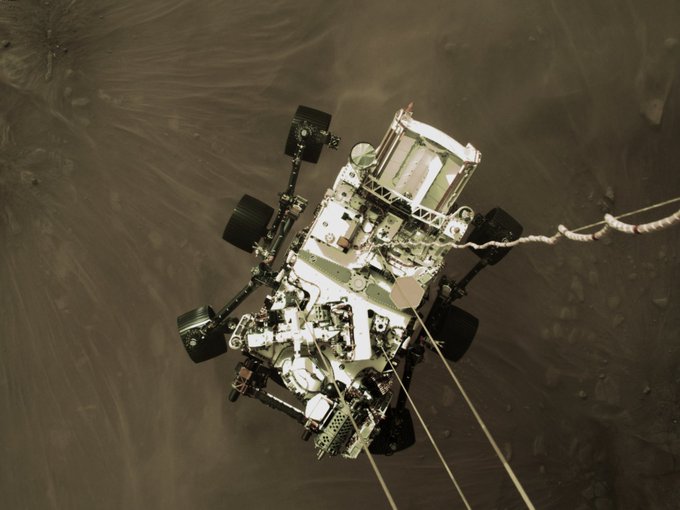You are not logged in. Please register or login.
- Topics: Active | Unanswered
Re: The Space thread
Holy shit.....
That is a picture from the skycrane lowering the rover to the Martian surface. After the skycrane lowers it to the surface, it snaps the cables and then launches itself away from the rover and crashes.
Just unbelievable technology.
We could do so much more with a bigger budget.
The best cameras haven't even been turned on yet. I think those start up in a couple days.
Fingers crossed for the helicopter to work. Within days we should be getting sound.
Re: The Space thread
Here's a Forbes article about the upcoming missions of 2021...
Three space missions from the UAE, China and NASA have now arrived at Mars. “Hope,” “Tianwen” and “Perseverance” may have reached the Martian system and are now poised to explore it, but what happens next for space missions in 2021?
Try this: NASA returning to the Moon’s surface, construction of a new Chinese space station, the first-ever mission to smash into an asteroid—and a nervy launch of humanity’s most expensive and important space telescope yet?
Here’s everything you need to know about eight spectacular space missions planned to launch in 2021:
1. China’s biggest-ever space station
Name of mission: Tianhe
When: March 2021
Even as Tianwen-1 orbits Mars and readies its rover, China could be launching the first parts of a massive space station. Tianhe (“heavenly river”) will be the first of six quick-fire missions to finish the Chinese space station by 2022, some of which will carry taikonauts (Chinese astronauts). This first module with lift-off from Wenchang Spacecraft Launch Site on the island of Hainan on a Long March-5B Y2 rocket.
2. NASA returns to the Moon
Name of mission: Peregrine Mission 1
When: June 20, 2021
To make its flagship Artemis program of Moon missions successful NASA needs to send a bunch of cheap, but risky science experiments to the Moon’s surface. First up in NASA’s Commercial Lunar Payload Services is Peregrine Mission 1, built by private company Astrobiotic. Its Peregrine Lunar Lander will take 14 payloads to Lacus Mortis, a large crater on the near side of the Moon. It will launch on United Launch Alliance Vulcan Centaur rocket from Cape Canaveral, Florida.
3. The first ‘asteroid redirect’ mission
Name of mission: Double Asteroid Redirection Test (DART)
When: launch between November 24, 2021 and February 15, 2022 (updated by NASA)
What would we do if we knew a near-Earth object (NEO) was headed for Earth? Could we deflect it? Seeking to find out is the Double Asteroid Redirection Test (DART), a mission from NASA and the European Space Agency (ESA) to crash into a binary asteroid called Didymos and Didymoon that will pass close to Earth in October 2022. The idea is to use a technique called “kinetic deflection” on Didymoon, essentially by crashing a 500kg spacecraft into it, and in doing so slightly change its trajectory. DART will launch on a SpaceX Falcon 9 rocket.
4. NASA probes a lunar lava tunnel
Name of mission: IM-1
When: October 11, 2021
Also due to launch on a SpaceX Falcon 9 from Cape Canaveral is NASA’s IM-1, a 14-day mission that will see the Nova-C lander touchdown near a collapsed lava tunnel in Lacus Mortis—the “Lake of Death”—a large crater in the Moon’s Ocean of Storms. Part of NASA’s Commercial Lunar Payload Services (CLPS) program and designed by private company Intuitive Machines, IM-1 will also test a precision-landing system.
5. A journey to Jupiter’s Trojan asteroids
Name of mission: Lucy
When: October 16, 2021
“Lucy” will be the first-ever spacecraft to explore Jupiter’s Trojan asteroids—ancient small bodies that orbit behind and ahead of the giant planet. Its 12-year mission will go something like this: get close to a small asteroid called 52246 Donaldjohanson in the Main Asteroid Belt (between Mars and Jupiter) in 2025 before visiting five Trojans in 2027 and 2028, then swinging back around Earth on its way to a final Trojan in 2033. It’s thought that the Trojans could hold clues to understanding the early Solar System and give clues about the origins of Earth’s organic material.
6. ‘Webb’ finally launches
Name of mission: James Webb Space Telescope (JWST)
When: October 31, 2021
Astronomy’s long-awaited and much-delayed new flagship space telescope is, at last, on the cusp of flight. A generation in the planning, and costing about $8.8 billion, the JWST or “Webb” is rated as 100 times more powerful than the Hubble Space Telescope. Its sunshield will be arranged origami-style inside a fairing atop an Arianespace Ariane 5 rocket that will depart from the European Spaceport’s launch complex in Kourou, French Guiana. Its mission? Observe the first galaxies, directly image exoplanets around saint stars, and generally change everything we know about the cosmos.
7. NASA tests the world’s most powerful rocket
Name of mission: Artemis-1
When: late 2021
NASA wants to go back to the Moon by landing the first woman and the next man on its surface in 2024 as part of the Artemis-3 mission. That’s ambitious, but the Biden administration seems keen, so it’s go for now. In preparation, Artemis-1 is an uncrewed flight test mission that will see the first test of the Orion spacecraft, European Service Model (ESM) and NASA’s Space Launch System (SLS)—the most powerful rocket in the world (but so far untested). It will launch from Complex 39B at NASA’s Kennedy Space Center, orbit the Earth, then Orion and the ESM will fly to the Moon and enter an elliptical orbit that takes them from 62 miles above its surface to 40,000 miles beyond it. It will splashdown off Baja, California.
8. India’s second attempt to land on the Moon
Name of mission: Chandrayaan-3
When: late 2021
India’s budget Chandrayaan (“mooncraft”) missions to the Moon are back. After having found water on the Moon with 2008’s Chandrayaan-1, Chandrayaan-2 crashed into the Moon in 2019. Cue Chandrayaan-3, a repeat mission that see a lander and a rover sent to land on the Aitken basin at the Moon’s south pole.
The Indian Space Research Organisation (ISRO) plans to launch Chandrayaan-3 in late 2021 from Satish Dhawan Space Centre (SDSC) in Andhra Pradesh. It’s slated to cost under $100 million.
Re: The Space thread
New image of the black hole in the M87 Galaxy....55 million light years away.
The lines are the magnetic field.
Same black hole they imaged two years ago. Too bad Hawking didn't live to see it.
It's sad when people like Hawking, Sagan, and Einstein die. The world really needs these types... especially Einstein now that breakthroughs are being made in quantum mechanics.


- Randall Flagg
- Rep: 139
Re: The Space thread
You still believe in space James? You should come over to the other side, much more fun.
Can you please elaborate on the premise beneath your question?
Re: The Space thread
polluxlm wrote:You still believe in space James? You should come over to the other side, much more fun.
Can you please elaborate on the premise beneath your question?
There's nothing going on up there. They discovered that with Von Braun's rockets. At a certain height they can't penetrate it.
Now it's just escapism for young men. Once you start looking at these space videos with the premise they were created in a studio or a computer you can never look back. A 2000 year old Greek theory they pass as real. But like Aristotle and every other ancient speculation, Pythagoras and Hipparchus were also wrong. The model of the Earth they use is based on a prop from a 1920s movie. Amazing prescience, or not.

- monkeychow
- Rep: 661

- Randall Flagg
- Rep: 139
Re: The Space thread
Randall Flagg wrote:polluxlm wrote:You still believe in space James? You should come over to the other side, much more fun.
Can you please elaborate on the premise beneath your question?
There's nothing going on up there. They discovered that with Von Braun's rockets. At a certain height they can't penetrate it.
Now it's just escapism for young men. Once you start looking at these space videos with the premise they were created in a studio or a computer you can never look back. A 2000 year old Greek theory they pass as real. But like Aristotle and every other ancient speculation, Pythagoras and Hipparchus were also wrong. The model of the Earth they use is based on a prop from a 1920s movie. Amazing prescience, or not.
So you don’t acknowledge the presence of interstellar objects visible with the naked eye? I just want to clarify what you mean by “nothing going on up there?” Do you believe chemical rockets can escape earth’s gravity? And if we don’t have geospatial satellites in orbit to include the ISS, how do you reconcile the use of ground satellite antennas and GPS?
Do you believe three dimensional space ends at some point in the atmosphere? Or do you believe our planet has an effective shield surrounding it.
Re: The Space thread
I can see why some people don't believe we're landing rovers with sky cranes on Mars....and also get why there's still questions over the Moon landings....but not going to space at all ?
I can't take that leap.
I don't like conspiracy sites anymore because they were ruined with politics and now Covid so I don't keep up on their current events.
Does this conspiracy still revolve around Operation Fishbowl?

